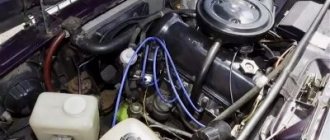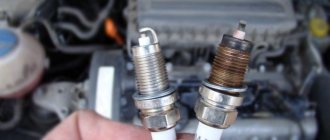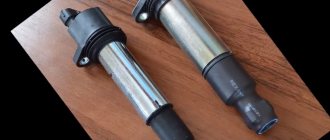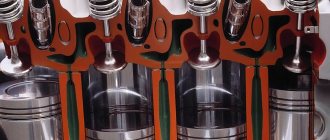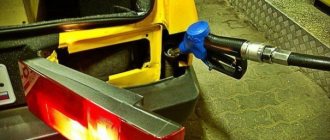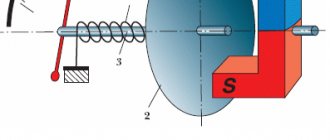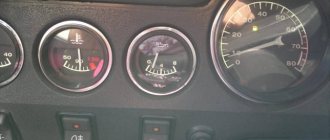The good performance of the VAZ 2114 engine is largely due to the good formation of the spark and fuel mixture. If one of these parameters is violated in a car, the engine may behave unpredictably.
Quite often, Samara 2 owners are faced with the problem of a stalling engine, and it occurs for many different reasons. This problem can really fray the nerves of those who are trying to solve this problem on their own.
In this article we will describe in detail how to independently diagnose the cause of engine tripping and failure of one or even two cylinders on a VAZ 2114.
Troit or not
How to understand that the engine in a VAZ 2114 is malfunctioning is quite simple, you just need to carefully listen to the operation of the internal combustion engine, and when driving, it is quite difficult not to notice that one of the cylinders is not working in the car.
Signs of a stalling engine:
- Loss of power;
- Vibrations;
- The engine shakes;
- Pops from the exhaust pipe;
If your car shows such signs of malfunction, most likely one or even two cylinders are not working.
SIGNS AND REASONS OF “ADJUSTMENT”
Signs: Engine trouble: what is it, and what are the signs to identify this malfunction? You can understand that the internal combustion engine is malfunctioning by the following signs:
- At idle speed, the engine operates unevenly, jerking periodically;
- The car does not develop the required power when driving;
- The car drives jerkily, when you press the gas pedal, there are gaps in operation;
- The exhaust from the muffler is uneven, with interruptions, pops and shots are possible;
- Fuel consumption increases.
Increased fuel consumption costs money.
Reasons: There are many reasons why the engine misfires. There are such nuances that even experienced technicians do not immediately determine the nature of the malfunction. But the most common cylinder failures are the following (starting with the elementary ones):
- The candle does not work;
- The high-voltage wire is broken;
- The ignition coil has failed;
- The control unit is faulty;
- There is an air leak in the intake manifold;
- Exhaust valve burnt out;
- The cylinder head gasket is broken;
- The compression rings on the piston are broken,
- The piston itself has burned out, or the bridge on the piston between the compression rings has burst.
This article is about the VAZ 2114 car, so carburetor malfunctions are not considered, since this device was not installed on the 2114 model. This brand of car has a fuel system with distributed injection (injector), and the answer to the question of why the engine stalls may be hidden in this system.
How to find out which cylinder is not working
In order to find out exactly which of several cylinders is not working, you can use two methods: checking through an OBD scanner and the good old test by elimination. Let's consider both options in more detail.
Scanner check
You need to purchase a special scanner ELM327, which connects to the OBD2 connector. Then the car diagnostic application is downloaded on the phone and paired with the scanner via Bluetooth.
The scanner reads errors from the electronic control unit through a connector and indicates a malfunction. Thus, it is possible to determine which cylinder has failed.
Checking by elimination
This check involves listening to the sound of the engine. If the car is shaking, then you need to open the hood, remember the sound of the internal combustion engine and, one by one, using pliers with insulated handles, remove the caps of the high-voltage wires from the spark plugs.
When the cap is removed from the working cylinder, the sound of the internal combustion engine will change and the engine speed will drop. This is a sign of normal operation of the cylinder, but if the sound of the engine does not change when the cap is removed, this means that this particular cylinder is not working.
How can you tell if a cold engine is leaking?
Motorists often understand this by the characteristic sound of its operation. This is especially audible through vibrations and the sound of the exhaust pipe. Also, a red “Check Engine” light may appear on the vehicle’s instrument panel.
There are other signs indicating that the engine has begun to stall:
- Body vibrations. The engine block itself may also shake.
- Unstable idle speed.
- Increased fuel consumption.
- Noticeable loss of engine power.
But it is worth noting that each of these symptoms may indicate other breakdowns. Therefore, they need to be considered only as a whole.
Reasons why the engine starts to stall
Engine trouble occurs for several reasons. When a cylinder fails in an internal combustion engine, it greatly affects its operation and it is simply impossible not to notice this.
List of reasons why the internal combustion engine fails:
- Wear of high-voltage wires;
- Failure of spark plugs;
- The ignition module is faulty;
- Clogged fuel injectors;
- Valve burnout;
- CPG wear;
- Failure or incorrect operation of the DPKV;
- ECU failure;
As you can see, there are quite a few reasons for the appearance of this malfunction on the VAZ 2114, and in order to understand which of them is the source of the breakdown on your car, you need to check all points and exclude some points in order to come to one conclusion.
No spark or weak sparking
If a spark appears, then move the spark plug away from the mass by 1 cm and repeat the previous action again. If the spark has noticeably weakened and is barely visible, then we have poor sparking.
Poor spark formation or no spark at all may be caused by the following faults:
- high resistance of high-voltage wires, or wire breakage;
- To do this, you need to check the high-voltage wires and replace them (the high-voltage wires may not be installed correctly);
- ignition module malfunction - check and replace;
- ECU malfunction - have it repaired or replace it with a new one;
- DPKV malfunction - its malfunction will be indicated by an error that can be read using the BC or carried out diagnostics. A non-working sensor needs to be replaced;
- again, the timing belt could have slipped a couple of teeth - disassemble it and reinstall it according to the timing marks.
If there is a spark, and a good one, then all that remains is to look at the rings, compression, valves, injectors, which have already been described above. We wish you good luck in finding your problem!
Why does the VAZ 2114 cylinder not work?
In order to make sure exactly why the cylinder failed, it is necessary to check all the elements that could cause the cylinder to fail.
Always start with the spark plugs
Checking the spark plugs
Checking the performance of the spark plug must be done on a special stand or by unscrewing the spark plug and putting it on its cap and placing it on the valve cover. Then ask someone you know or passerby to turn the starter. A spark should appear on the spark plug periodically. If it is missing, then the reason is in the candle.
It is better to check the spark plug on a cylinder that was initially in working condition.
Checking wires
High-voltage wires are made of special material with high insulation resistance to ensure reliable transmission of high voltage to the spark plug.
It is necessary to inspect the wires for breaks or damage to the insulation. The wire cap must be securely fixed to the spark plug and press the contact tightly against it.
If the wires have a characteristic worn appearance, they must be replaced.
Ignition module
The ignition module on the VAZ 2114 has two coils inside, each of which regulates the voltage supply to two cylinders. For example, the first coil is responsible for the operation of 1-4 cylinders, and the second is responsible for the operation of 2-3 cylinders.
From this we can conclude that if two cylinders, namely 1-4 or 2-3, do not work at once, then most likely there is a breakdown in the ignition module.
You can accurately verify this by removing this part from another car and installing it on a faulty car for testing.
Clogged fuel injectors
The injectors spray fuel into the combustion chamber. The VAZ 2114 has one injector for each cylinder. If one of the injectors becomes clogged, then the operation of this cylinder becomes impossible due to the lack of fuel mixture in it.
Checking the injectors can be done by measuring the fuel pressure and opening one of the injectors. The best way is to remove the fuel rail and wash the injectors.
Valves problem
Burnout of valves significantly affects the operation of the entire internal combustion engine. It occurs due to incorrect valve adjustment, namely when the valve is pressed and constantly open.
Also, if the valves are not adjusted correctly, engine tripping may occur.
You can check this by measuring the compression. To do this, instead of a spark plug, we screw in a compression gauge (a device for measuring compression in the engine) and the starter turns several revolutions. If there is no compression or it is much lower, then most likely the valve in the internal combustion engine is burnt out or incorrectly adjusted, or the CPG is worn out. To prevent wear on the CPG, it is necessary to drop some engine oil into the engine and measure again. Engine oil helps increase compression when the piston and rings wear. If there is no compression upon repeated measurement, then there is a problem with the valve.
DPKV failure
The sensor that takes readings from the rotation of the crankshaft is called DPKV. It determines the position of the piston in the engine and sends signals to the ECU. The sensor is directly involved in spark formation. If it fails, there will be no spark on all four cylinders and the engine will not be able to start.
Breakdown in the ECU
The control unit contains an electrical board with a large number of radio elements. Each element is responsible for a specific sensor. Special keys are responsible for the operation of the ignition module, which quite often fail, which makes it impossible to supply a spark to a certain cylinder.
If the engine in your car is not working, and you have tried all the methods, then it is best to contact an experienced electrician who can diagnose a breakdown in the engine control unit.
Reasons for incorrect engine operation
When we stop, we find out that the VAZ 2110 injector is causing problems with the engine and fuel consumption, which will be noticeably higher than on other days. This is in the case that the driver does not suspect incorrect operation of the power plant, both while driving and when starting the engine “cold”. It is extremely important to eliminate such a defect when the VAZ engine speed fluctuates, an uneven rumble of the engine is heard, the power plant vibrates, otherwise in the future this can lead to a complete failure of the engine unit.
It turns out that when working on three cylinders, a fuel-air mixture accumulates in the idle element, which is not burned. This mixture enters the oil sump, mixes with the engine lubricant, changes its consistency and viscosity, reduces its lubricating properties, which ultimately leads to a significant decrease in compression performance. There is also a sharp increase in wear of the piston group of the power plant and mating rings, and, as a result, will soon lead to a major overhaul of the engine unit.
We recommend: Do-it-yourself oil change in the Nissan X Trail T31 variator
The reasons why the engine in the VAZ 2110 is throttled have several reasons. For verification it is necessary to carry out certain operations. Let's start searching for a defect by identifying the cylinder that is not working; to do this, you need to perform the following technological operations:
- We start the engine and open the engine compartment.
- We listen to how the engine works and remember the nature and mode of its operation.
- We begin to remove the high voltage wires one by one. When removing the high-voltage wire, the nature of the operation of the power plant and its tone changes, because The cylinder spark plug is de-energized, which causes the cylinder to stop working. If, when the wire is removed, the character and tone of the engine does not change, then this is a non-working cylinder.
- Next, you need to establish the flow of spark from the ignition system into the cylinder, which will make it possible to understand the causes of the defect.
- Next, we begin to test the spark plug of the faulty cylinder. After removing it from the cylinder head, using a spark plug wrench, we study the working conditions of its electrode tip. If there is soot or soot on the electrode, then these defects will interfere with the correct operation of the product, because it prevents the passage of the spark, and it produces a weak current at the output, or the current does not pass at all. Cleaning this element of the ignition system will extend the operation of the vehicle for some time, but it is necessary to determine the cause of the spark plug defect.
- To do this, we test the spark plug for spark. To determine the real reason why the engine is stalling, we test the passage of a spark from the ignition distributor.
- To do this, remove the spark plug, insert it into the tip connected to the high voltage wire and apply the electrode to the mass of the power plant so that there is a gap of half a centimeter between them. Next, with the help of another driver, turn on the starter and crank it over. If there is no spark while the starter is turning, we move the spark plug back a centimeter and continue the test in the same way.
Other engine triple options
There are several other options when the engine troits, for example, when the internal combustion engine is cold it works fine, but as soon as it warms up one of the cylinders begins to fail, or vice versa, when it is cold it troits, but as soon as it warms up the engine starts to work normally.
Let's consider each of the options.
VAZ 2114 engine troits when cold
This problem occurs in such cases when:
- Problems with the fuel mixture;
- Bad spark plug;
- Condensation has accumulated on the spark plug or ignition module;
- Large gap between the valve and the camshaft cam;
- Compression rings and piston are worn;
The VAZ 2114 engine troits when hot
This problem is more pronounced when there is electrical damage to the elements.
- ECU malfunction;
- Breakdown of the MZ coil;
- The cylinder head gasket is broken;
Injection engine
Engines with injection are a real mystery for many car enthusiasts, because they are electronics – a “black box”.
Sometimes you can even hear the opinion that if the engine is misfiring on a fuel-injected car, then you need to immediately take the equipment to a service station.
But a competent car enthusiast can still perform some activities on his own.
The main reason
This is a lack of spark in one of the spark plugs. In such a situation, further troubleshooting is very confusing - you have to check coils, switches, sensors and even the car's ECU.
And here it is really difficult to cope on your own - you need to go for computer diagnostics to specialists in their field.
Injector malfunction
If there is a spark, the second most likely cause of failure may be the injector. It is not difficult to identify such a malfunction. With the engine running, it is necessary to disconnect the chips from the injectors one by one.
The task is to find one whose disabling will not lead to changes. Try swapping injectors.
If a cylinder with a “faulty” injector works normally, then the fault will have to be looked for elsewhere.
Fuel pump malfunctions
There is an opinion that the engine may stall due to a faulty fuel pump. But in this case, the problem will alternately “creep out” on all cylinders (and not specifically on one).
Moreover, if the fuel pump malfunctions, the engine may not start at all. In this situation, the only way is to send the car to an electrician for diagnostics.
Air flow sensor
Another probable cause is a malfunction of the air flow sensor.
Of course, you can detect the main faults yourself, but there are also some that only a specialist can help identify.
Main reasons and their definition
When the engine in a VAZ 2109 stalls, the sound of the running engine acquires a characteristic timbre, where elements of vibration and rattling can be heard, and the engine power unit does not gain speed and operates unstable.
Breakdown of high-voltage wires of the VAZ 2109 is one of the reasons why the VAZ engine may start to fail
At the same time, the engine speed is unstable, its operation is not uniform, it makes sounds as if the engine is overcoming some invisible obstacle. The muffler emits intermittent exhaust with an uneven period of exhaust emission.
Causes of unstable engine idling
Most often, a situation arises when the engine stalls at idle speed. Moreover, it makes no difference whether this happens when it’s cold or when it’s hot. There can be many reasons for this, ranging from a simple spark plug failure to malfunctions in the piston group of the internal combustion engine. While it is very easy to replace a spark plug, wear on the cylinders in the block can lead to a major overhaul.
Most often, the engine does not operate stably at idle in the following cases:
- The valves are not adjusted (clamped);
- The timing belt is installed incorrectly (the marks do not match);
- The IAC is faulty;
- The cylinder head valves are bent or burnt out (the valves can bend during a water hammer when a large amount of water gets into the air filter housing);
- The piston burned out;
- There is a malfunction in the electronic engine control system. The sensors, the ECU itself, electrical wiring and I/O wires may be to blame here.
There are many options for why the car idles at idle, but there are still the most basic ways to determine faults.
Reasons why an unheated VAZ 2109 engine fails
Soot on the spark plugs of the VAZ 2109 indicates the presence of a poor fuel-air mixture (another reason why the VAZ 2109 engine stalls). It
often happens that the VAZ 2109 stalls when cold, and as it warms up, the engine levels out and begins to work stably.
There could be several reasons:
- The ECU sets the fuel mixture too rich to cold;
- The spark plug does not work, but when heated, the spark plug still “breaks through”;
- The high-voltage wires are damp or moisture has entered the ignition coil;
- Parts of the piston group are worn out.
The term troit engine VAZ 2109 means
The term “troit engine” appeared in the era of automotive development, when vehicle power plants were equipped with four-cylinder engines. If, for one reason or another, the working cylinder stopped functioning, then three cylinders remained in operation, which during operation made a characteristic sound, as if the engine was stalling in a damped mode.
Engine compression measurement for VAZ 2109
Subsequently, despite the complication of the design of the piston group and the increase in the number of cylinders, the term “troit engine” remained in use among car enthusiasts.
Why the engine stalls when hot - diagnostic algorithm
By following these instructions, you can find the cause of the problem and repair your car yourself.
Spark plug
Remove the high-voltage wires from the spark plugs and unscrew the spark plugs. Inspect contacts and insulators. Contacts and insulators of serviceable spark plugs must be dry. If they are covered with oil (“wet”), we have a probable cause of “triple”.
Spark plugs become “wet” if the oil entering the combustion chamber when lubricating the cylinder-piston group does not burn. For one of two reasons: 1. Too much oil gets into the combustion chamber. 2. The fuel mixture in the combustion chamber does not ignite or does not burn completely. Often both causes are present simultaneously, or one as a consequence of the other. That is, too much oil gets into the combustion chamber, the spark plug contacts become dirty, a spark does not occur or it is weak, the fuel does not ignite (or does not burn completely). Or vice versa. There is no spark, the fuel does not burn, the contacts become oily. An important feature is that the contacts of all spark plugs, or just one, are oiled.
Step by step
- Check the engine oil level. Perhaps its level is higher than normal. Without considering the unpleasant case of a breakthrough of coolant into the crankcase (here the symptoms will be somewhat different) - most likely it was simply overfilled. As a result, the oil pressure in the engine is higher than normal, the excess enters the combustion chamber, the contacts become oily, and the spark periodically disappears from one or more spark plugs. Check the crankcase breather (ventilation) hose: it may be clogged with dirt, frozen condensate (in winter), simply bent or incorrectly installed. The results are the same. In principle, these reasons should be accompanied by indecently high oil pressure in the engine, which can be seen on the dashboard, but... The sensor (light) may simply be faulty and not show this. In this case, if the tripping disappears after draining the excess and cleaning the ventilation, the sensor (light bulb) must be replaced. The spark plugs do not match the engine type (too cold). And don’t think that the markings on the candles and what’s written in the “books” are the ultimate truth. This is checked by installing a set of spark plugs that is known to work (from another car) and checking the operation of the engine on them. If there is no friction, change the spark plugs. New spark plugs are not a panacea here - they may also turn out to be faulty or not suitable for their specifications. Power system malfunction. If the engine is equipped with self-diagnosis, perform it. If not, take it to the service station. Most likely there is a failure in one of the sensors or controllers: lambda probe, DVRM sensor, WTi regulator, you never know... In “smart” engines, even incorrect readings of the coolant temperature sensor can lead to tripling. The controller incorrectly calculates the fuel supply parameters, over-enriches the mixture and... as a result, the spark plugs are “flooded”.
Let's start with why the engine triples, and not “doubles” or “quadruples”, for example :-)
The fact is that quite recently most engines had four cylinders, probably no one would have believed that there could be six, eight or twelve 30 years ago, but oh well... In general, when one of the four cylinders stopped working, then the workers There were only three cylinders left, and the sound of the engine was seriously changing. This phenomenon is called engine throttling, that is, the engine runs on three cylinders with a characteristic sound. Years passed, the number of cylinders changed, but the term troit remained unchanged.
Power system diagnostics
The engine is running hot, the reason is that only one spark plug is “wet”, and the rest are “dry”.
- If the tripping continues, swap the “dry” and “wet” spark plugs. Check, unscrew the spark plugs. If a dry spark plug remains dry and a wet spark plug stays wet, the cause is the spark plug. Replace the faulty (“wet”) one with a serviceable one. If the “dry” has become “wet”, and the “wet” has become “dry”, we return to the high-voltage wire. We replace it with a good one and check it. Important: specifically for a tested and working one, and not for a new one. No one has yet canceled a factory defect. If this does not help, we move on to the ignition system. In older engine models, high-voltage wires were connected to the ignition distributor (distributor); in new ones, each cylinder (or pair) is equipped with an individual ignition coil. Dry the distributor cover, clean and adjust the contacts, or replace it entirely. Well, a spare distributor cap in an old car should be a must, like a first aid kit with a fire extinguisher. In new engines, swap the ignition coils from adjacent cylinders. Naturally, wires too. Check it out. If necessary, replace the faulty coil.
It should be noted that checking for a spark with a spark plug removed from the engine does not help much. Such a common reason as the failure of an individual ignition coil of a modern engine may lie not only in the absence of a spark, but also in its weak strength. Or in general - the power of the spark is excellent, but... when the coil heats up, either the power of the spark drops, or its combustion phase “floats” and it does not ignite the fuel mixture. Why should the performance of an individual ignition coil be checked experimentally, and not according to self-diagnosis and engine tests: diagnostics and self-diagnosis will not show malfunctions of a “dying” coil, that is, a coil that periodically operates in abnormal mode. It can “die” for a year, and self-diagnosis will consider it normal all this time - after all, during the test it shows the norm... As practice shows, it is the abnormal operation of the individual ignition coil that most often leads to “hot” engine tripping.
The operation of the motor can be accompanied by various problems. All of them must be immediately eliminated. For example, a VAZ 2110 engine with an 8-valve injector shakes at idle, but after the car warms up enough, everything comes back to order. Many car owners try not to focus on this and continue to operate the car. Meanwhile, they do this in vain, since the existing problem requires a solution.
Symptoms of a problem
If you know about the main signs and symptoms of a motor malfunction leading to tripling, it will be much easier for you to solve the problems that arise.
There are several signs in total.
- The engine runs rough at idle, shaking and vibrations occur, which are clearly felt inside the cabin. This phenomenon cannot be confused with anything and the verdict is clear - one of the cylinders has failed. This symptom appears even when the unit is broken.
- Blackening of the electrode for spark plugs, presence of soot and soot. It is not enough to simply replace the spark plugs with new ones, since this does not eliminate the cause of soot formation.
- The exhaust changes its sounds. When tripping, the exhaust sound literally shakes the car. Experienced drivers notice this quickly and easily.
- The appetite of the power unit is noticeably growing. There can be many reasons for increased consumption, so a full diagnosis will be required.
- Dynamic performance decreases, speed and power drop. At low speeds it is not difficult to notice when picking up speed. But this can be caused by cylinder failure, that is, tripping, or other reasons.
- The revolutions are floating. This is easy to notice by looking at the tachometer needle. Changes, that is, fluctuations, can be serious or minor, in the range of 100 revolutions.
- When accelerating, you can feel the engine jerking in any gear.
To understand why the engine stalls at idle or in gear, you need to understand the possible reasons for this phenomenon.
Causes
The reasons for engine tripping are different. But they are most often caused due to the failure of one of the following units:
- Ignition system;
- Candles;
- High voltage wires;
- Vacuum booster;
- Air filter;
- Distributor;
- Incorrect adjustment or burnout of valves;
- Piston rings.
We recommend: Replacing the fuel pump mesh on Kalina
Now let’s take a closer look at the reasons and actions you can take in a given situation.
The revolutions are floating
| Cause | Your actions |
| The ignition was set incorrectly | It’s not uncommon for an engine to misfire because the ignition was set incorrectly. The problem is determined by skipping a beat, the appearance of popping noises, and bouncing of the engine. Listen to how the motor works. If the tripping occurs at idle, but when you start driving and increase the speed, the problem goes away, then the ignition is too early. It needs to be adjusted. |
| Vacuum booster problem | It may be damaged, the tightness of the diaphragm or valve may be compromised. This leads to the appearance of air inside the system, the mixture becomes “leaner” and does not ignite properly. As soon as there are literally 2 omissions, the candle will get wet and will not be able to work. If there are problems with the amplifier, the engine will fluctuate at idle, when the engine is hot and cold |
| Spark plug | Another common problem is engine tripping, accounting for about 50 percent of all cases. To solve the problem, periodically inspect the spark plugs, clean them and change them. Moreover, it is recommended to perform the replacement as a complete set, and not just each candle individually |
| High voltage wires | If breakdowns occur in one of the high-voltage circuits, the spark will not be able to reach its spark plug. As a result, the motor stalls and does not work properly. To check, turn off the lights, start the engine and watch the area from the distribution coil to the spark plugs. If a spark appears in the gap, this indicates the presence of a hole in the capacitor or wire insulation. A temporary solution is electrical tape, but then the wire must be replaced |
| Air filter | If the air filter becomes clogged and dirty, the engine will simply suffocate due to lack of oxygen. This situation is relevant for those who, when changing the oil, ignore the recommendation about the need to simultaneously replace the air filter. As a result, the spark plugs are flooded, the mixture becomes lean, and the engine suffers. Just change the filter and the problem will go away |
| Piston rings | Piston rings rarely become deformed, but this situation cannot be ruled out. To make sure everything is fine with this unit, perform a compression test. If the compression level in one of the cylinders is too low, try adding a little oil to it. If the problem goes away, then the reason is definitely in the rings. They need to be replaced |
| Valves | If valve clearances are violated, the entire system suffers. Because of this, periodically one of the cylinders cannot receive the required amount of air-fuel mixture. With such a malfunction, the engine will misfire at idle, when the engine is hot, when the engine is cold, and when driving. To fix the problem, you need to remove the cylinder head and adjust the valves in accordance with the instruction manual for your VAZ 2110 with the engine installed on the car. Different engines have their own nuances |
| Distributor | Not very often, but the distributor also sometimes causes the engine to trip. This assembly has three weak points - the turntable bearings, shafts and bushings. Over time and as the vehicle is used, they wear out. Therefore, if the culprit is the distributor, try replacing it completely or carry out partial repairs with a repair kit, replacing worn elements |
| Burnt out pistons or valves | A problem we don't want anyone to face. This is a serious engine failure that will require a complete repair of the power unit. The main difficulty is the need to disassemble the engine and visually inspect the pistons and valves. Carry out such a check only if all previous measures did not produce results and did not allow you to identify the culprit |
Checking pistons and valves for burnout can only be carried out by a specialist with sufficient experience. It is not recommended for beginners to carry out such activities on their own.
We recommend: Easy replacement of the timing belt on the Opel Astra H 1.6 Z16XER
Engine trouble is a simple symptom that can appear as a result of all sorts of breakdowns and defects in your engine. Therefore, your task is to find the cause of the tripping and promptly eliminate it. If you delay repairs, the consequences can be catastrophic for your car and budget.
Why does a car run on gas?
Quite often a problem arises when a car idles on gas with a cold engine, but when switching to gasoline everything works fine. There are few reasons for such a malfunction. The most common of them:
Damaged diaphragm in the gearbox
- clogging of gas filters;
- loose or loose connections of gas installation pipes;
- malfunctions of the gas reducer - damaged or contaminated membrane, poor-quality or used seals;
- partially or completely inoperative gas injectors. As a rule, the main reason for their malfunction is contamination;
- Incorrect setting of HBO.

